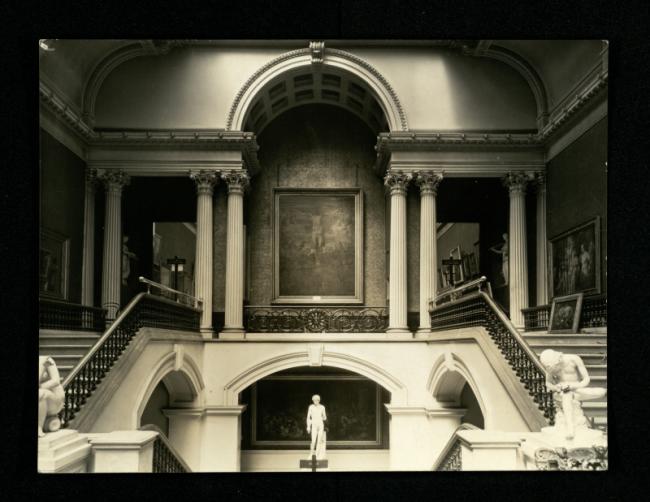The war that closed the Gallery
The Irish Civil War (1922-1923), unlike previous conflicts that were discussed in the minute books, had a direct and intense impact on the National Gallery of Ireland. In a stark contrast to the decision of the board to keep the Gallery open during World War I, during the Irish Civil War we can deduct from the minute books that the Gallery was closed as a result of the unrest from at least October 1922, if not earlier.
The impact of the conflict on the Gallery only deepened in December of 1922, with the Director, Robert Langton Douglas, reporting that the Gallery was to remain closed for the foreseeable future, and it had also sustained gunfire damage. While the Civil War was clearly affecting the physical Gallery building, it was also affecting the development of the collections which were housed inside it. During the meeting held on April 1923, the board heard how donors were hesitant in giving pictures to the Gallery due to the “disturbed nature” of the country. In particular, it is brought to the attention of the board that a donor is reluctant to present Sydney P. Hall sketches of the Parnell Commission, however they need not have worried – the pictures were presented to the Gallery in 1927.
The Irish Civil War officially came to an end in May 1923, and in February 1924, a letter from the Ministry of Home Affairs stated that there were:
no longer any military considerations to interfere with the opening of the Gallery… , and … the Director should take immediate steps to bring the Gallery staff to full strength and to arrange with the Minister for a full or partial opening of the Gallery
Letter from the Ministry of Home Affairs, 1924
The Collection in the 1920s
The photograph below, taken c.1920, shows Venus and Adonis by Jacopo Tintoretto on the right wall. In the foreground, on the left, is the Crouching Venus by Giacomo Vanelli, a copy of a Hellenistic marble held at the Uffizi, which was presented to the Gallery in 1863 by Mrs Carmichael. Standing in the centre of the stairwell we can see is Adonis by Francois Marie Poncet, derived from the Classical marble of Apollo in the Louvre, and presented in 1878 by the 4th Duke of Leinster, Charles FitzGerald.
The statue on the right is Spinario or Boy Extracting a Thorn by Giacomo Vanelli. The large painting in the centre is Christ on the Cross, with St. Francis and St. Anthony of Padua by Panico, purchased from Signor Aducci in 1856. Maclise’s large painting, Merry Christmas in the Baron’s Hall, hangs in the centre of the stairwell below.
Collection developments during the 1920s included the Edward Martyn (1859-1923) bequest of seven paintings including works by Corot, Monet, and Degas. In 1925 the Gallery received its first gift through the Friends of the National Collections of Ireland: a drawing entitled Silenus and King Midas by Giuseppe Passeri. O’Callaghan also purchased Pieter Lastman’s Joseph Selling the Corn in Egypt and A Sick Call by Irish artist, Matthew James Lawless.

